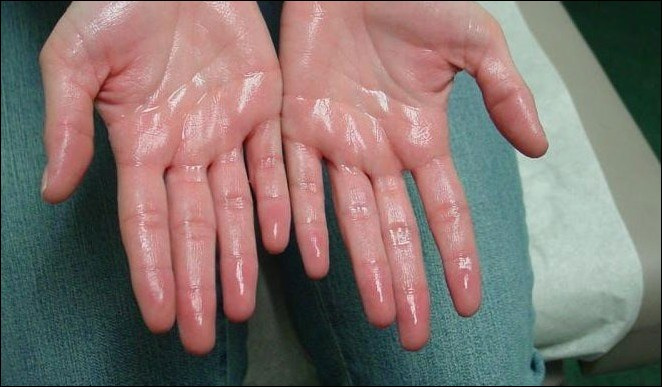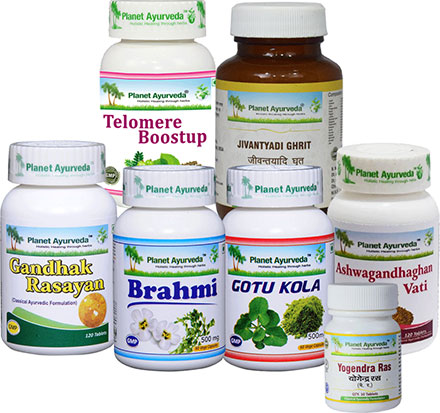Hyperhidrosis – Symptoms And Causes Treatment By Ayurveda
Abstract
Sweating is the basic body mechanism to make the body cool. Whenever we exercise or exert ourselves, the body feels the heat. At that time sweating happens as a bodily response to normalize the body temperature. There are approximately three million sweat glands in the body. Factors that are responsible for sweating our emotions, stress, raised temperature, medications, or illness. In case sweating occurs profusely without exertion, such a condition is called hyperhidrosis. The sweating experienced with hyperhidrosis is much more than normal sweating. In this article, we will discuss the concept of hyperhidrosis, its causes, types, clinical features, complications, and its ayurvedic aspect in detail.

Introduction
Hyperhidrosis in simple words can be defined as a condition that is associated with excessive sweating in an individual. Hyperhidrosis happens as a primary process of neuronal dysfunction. In hyperhidrosis sweat may soak through the wearing or may drip from the body parts. In this condition, a person may feel sweating without doing any physical work. Sweat in hyperhidrosis is not related to external heat or exercise. A person may sweat profusely without much exertion. Sometimes this condition leads to stress, embarrassment, or anxiety. Hyperhidrosis usually disturbs the normal day-to-day life of the person. An emotional stimulus is also responsible for the activation of sweat glands of the soles and palms. Premotor and frontal projections of the hypothalamus are responsible for the increased emotions and hence promote sweating. A person suffering from hyperhidrosis usually does not feel sweating during sleep.
Types of Hyperhidrosis
Two types of hyperhidrosis are as follows
1. Primary Hyperhidrosis: This type of hyperhidrosis doesn’t have any specific reason. It might be hereditary and early signs can be seen in childhood. The affected areas are the hands, feet, groin, underarms, and armpits. It is one of the most common types of hyperhidrosis.
2. Secondary Hyperhidrosis: This type of hyperhidrosis affects a large area, almost every part of the body. It is not prevalent and in comparison to primary hyperhidrosis, it is less common. The exact cause is unknown in this type of hyperhidrosis.
Causes
One of the main causes of hyperhidrosis is the hyperactivity of sweat glands. The other causative factors are neurologic, endocrine, and recurrent infections. Heat or factors which aggravate emotions or stress are also responsible for causing hyperhidrosis. are sweat glands.
Clinical features
- The palms of the hands become wet or clammy
- The soles of the feet become clammy or wet
- Sweating which can be regular
- Sweat can drip through the clothes
- Fungal or bacterial infections. Other skin problems can be associated with hyperhidrosis
- Foul smell from the body or armpits
- Poor self-esteem
- Unable to build physical contact
- Self-conscious
- Depression or unable to fix a good social life
- Isolation
The basic complications of hyperhidrosis are
- Infections. People who sweat profusely are more prone to skin infections.
- Social and emotional effects. Having clammy or dripping hands and perspiration-soaked clothes can be embarrassing.
- Your condition may affect your pursuit of work and educational goals.
Diagnosis
The basic test for the diagnosis of hyperhidrosis is the thermoregulatory sweat test. In this test, a powder is applied to the skin. This powder is usually sensitive to moisture. In case excessive sweating occurs even at room temperature can cause the powder to change its color. After performing this the next phase is high heat. The person is exposed to excessive humidity. Persons who are suffering from hyperhidrosis tend to sweat heavily on their palms. The people who are normal do not suffer from any such complaint when exposed to heat. This test also clarifies the severity of the condition.
Management
The management of Hyperhidrosis started with antiperspirants ( Odaban, driclor). Antiperspirants are the basic and first line of treatment for Hyperhidrosis. If in case the medications don’t work surgery sometimes is also suggested. The surgical procedure is associated with the removal of sweat glands or the disconnection of nerves concerned with sweat overproduction. Anticholinergic agents (glycopyrrolate, methacholine bromide, oxybutynin) and alpha-adrenergic agonists (clonidine) are most commonly used in clinical practice.
Ayurvedic aspect
According to the ayurvedic aspect, hyperhidrosis can be correlated with Sweda vaha srotas dushti. Sweda means sweat, it is a waste of tissues, especially the fat tissues, and dhatus. Pitta dosha is also associated with it. When the pitta dosha gets aggravated there is the feeling of excessive heat in the body and the person may suffer from profuse sweating. There is the presence of Sweda vaha srotas, these srotas are basically the sweat-carrying channels located in our skin, pores, and hair follicles. Hyperhidrosis might be a resultant factor of aggravated pitta dosha. Ayurvedic concepts reflect that if there will be contamination of channels in the body, the problem will arise with the concerned system of that channel. Ayurvedic concepts suggest that sweat is metabolized from fat. The other factors associated are obesity, virus aahar vihar (incompatible food), excess exposure to heat, anger, or fear.
Ayurvedic herbs and tips for the management– Various herbs are beneficial to manage the Pitta dushti and aggravated sweating. Herbs like Giloy (Tinospora cordifolia), Mukta (Natural Calcium Compound from Pearls), Kaharwa (Natural calcium compound), Ashwagandha (Withania somnifera), Tagar (Valeriana wallichii), Brahmi (Bacopa monnieri), Amla (Emblica officinalis), Haritaki (Terminalia chebula), Bahera (Terminalia bellerica), Vacha (Acorus calamus), Neem (Azadirachta indica), Manjistha (Rubia cordifolia), Daruhaldi (Berberis aristata), Safed Chandan (Santalum album), Kababchini (Piper cubeba), Safed Ral (Shorea Robusta), Gandha Biroja (Pinus longifolia), Katha (Senegalia catechu), Amalaki (Phyllanthus emblica), Kapur (Cinnamomum camphora), Gairik (Red Ochre), Pashanbhed (Bergenia ligulata), Gokshura (Tribulus Terrestris), Choti Elaichi (Elettaria cardamomum). These herbs promote the overall metabolism of the body and help to balance the aggravated pitta dosha and other associated dosha in the body. These act as the chief ingredients in various formulations of Planet Ayurveda like Pitta balance, Brahmi vati, Chandanadi vati, Amalaki rasayan, etc. These herbal formulations of Planet Ayurveda are the best, authentic, and result-oriented with no side effects.
With the above herbs, the following tips can be beneficial to manage hyperhidrosis and decrease the level of sweating or to keep the body hydrated
- Water intake: It is the most common and easy way to deal with the condition of hyperhidrosis. Hydration therapy is best to improve the water level of the body. The composition of sweat is mainly water with some other electrolytes. In conditions like hyperhidrosis, there is the presence of profuse sweating hence the heavy loss of water. So to maintain the level of water in the body, hydration therapy is very important.
- Use of raisins: Raisins help to maintain the electrolyte imbalance and help to recover the electrolytes essential for the maintenance of the body. Raisins soaked in water overnight help to pacify the pitta.
- Seasonal fruits and vegetables: Fruits are the richest source of antioxidants. Obese persons are more prone to hyperhidrosis and usually feel more sweating. Consuming fruits helps to maintain good body weight and also enhances the levels of nutrients.
- Coriander seeds: Coriander is a good pitta shamak and a potent energy booster. It helps to pacify the aggravated pitta dosha. Concerned persons may take it on an empty stomach daily for a long period of time. Coriander helps to detoxify the body and drain out free radicals.
- Amla churna and jaggery: Due to the cold potency of amla and its rejuvenator action it helps to pacify the pitta dosha and stabilize the response of the hypothalamus.
- Reduce the intake of caffeine: caffeine promotes sweating. So if a person reduces the intake of caffeine, it will help to counter the condition of hyperhidrosis.
CONTACT PLANET AYURVEDA TO PROVIDE YOU WITH THE COSTING / ORDERING AND DELIVERY INFORMATION AT – COSTING.PLANETAYURVEDA@GMAIL.COM OR CALL AT +91-172-5214040
Conclusion
In conclusion, we can say that sweating is a natural phenomenon of the body. But in case excessive sweating will be there and become more profuse without excessive exertion then it is important to take action. One must include a Pitta pacifying diet, follow the cold potency dravya, and do pranayama like sheetali or anulom vilom. The herbal products of Planet Ayurveda are the best, authentic, and pacify the pitta. With the herbs mentioned above, the tips are also very useful. A person suffering from hyperhidrosis can follow the tips and promote freshness and a feeling of enjoyment. After getting rid of profuse sweating people will become more friendly, more attractive, and self-confident, and promote a healthy environment. The herbal formulations of Planet Ayurveda are also able to manage the associated complaints of hyperhidrosis.



